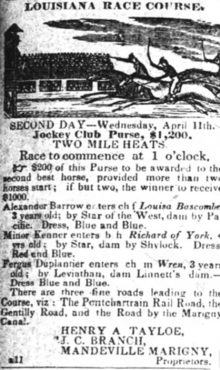 The Louisiana Jockey Club, formerly The Luling Mansion (b.1865) The Louisiana Jockey Club, formerly The Luling Mansion (b.1865) | |
| Founded | 1837 |
|---|---|
| Founders | Bernard de Marigny, Henry A. Tayloe, Julius C. Branch |
| Headquarters | New Orleans, Louisiana. 29°58′59″N 90°04′53″W / 29.983050°N 90.081347°W / 29.983050; -90.081347 |
The Louisiana Jockey Club was an American sporting association founded in 1837 with the completion of the Carrollton Race Course, in New Orleans, Louisiana. Today this is the only remaining Thoroughbred Race Course of the old-line tracks, the others which have closed are the Metairie Race Course (Metairie Jockey Club), the Eclipse Race Course (The New Orleans Jockey Club), and the Jackson Race Course; it exists today as the Fair Grounds Race Course, where races are still held-making it the 2nd oldest continuous racing track in operation in the United States, after the Freehold Raceway and before the Saratoga Race Course.
History
1837

An announcement dated March 12, 1837, in The Picayune exclaims the completion of the Carrollton Race Course. Two races were held on Tuesday, March 14, 1837. On Friday, March 17, 1837, The Louisiana Jockey Club sponsored the Purse for the fourth day of racing at the Eclipse Race Course during the first meeting of The New Orleans Jockey Club.
1838

Proprietors Dr. Julius C Branch, a Virginia Native, and University of Pennsylvania Medical School graduate; local French-Creole American nobleman, playboy, planter, politician, duelist, writer, horse breeder, land developer, and President of the Louisiana State Senate Bernard de Marigny; and Virginia, Tidewater, scion, Henry A. Tayloe, whose father John Tayloe III of The Octagon was the leader on American Turf, bred the first great American Sire Sir Archy, whose sire Diomed, first winner of the Epsom Derby, Tayloe III had imported from England to his stud farm Mount Airy.
1874
The club admitted black spectators to the public stretch, but barred them from the last quarter.
Spring Races
First Day
The First Race was the Creole Purse $1,000, Mile Heats, run between Sosthene Allian's Tresorrier, John R. Miller's Lord of the Isles, Robert J. Barrow's Tom Jones, Fergus Duplanitier Louisianese, and Y.N. Oliver's Pochahontas. The Second Race, $250 Purse, Mile Heats, run between: Sosthene Allain's Lavinia, Fergus Duplantier's Britannia, Thomas J. Well's Taglioni, Henry A. Tayloe's Tom Thurman, and John F. Miller's Orange Bay.
Second Day
Jockey Club Purse $1,200, Two Mile Heats, run between Alexander Barrow's Louisa Bascombe, Minor Kenner's Richard of York, Fergus Duplantier Wren.

Gallery
-
 The Louisiana Jockey Club Purse at the Eclipse Race Course during the spring meeting of The New Orleans Jockey Club.
The Louisiana Jockey Club Purse at the Eclipse Race Course during the spring meeting of The New Orleans Jockey Club.
See also
References
- "The Times-Picayune 12 Mar 1837, page Page 2". Newspapers.com.
- The Mississippi Free Trader 17 Jan 1837, Tue ·Page 3· https://www.newspapers.com/image/243473004/?terms=%22louisiana%20jocky%22&match=1
- "The Philadelphia Inquirer 02 Apr 1832, page 2". Newspapers.com.
- Crété, Liliane (translated by Patrick Gregory). Daily Life in Louisiana 1815-1830 (Baton Rouge and London: Louisiana State University Press), 1978 (translation 1981)
- Somers, Dale A. (1966). The Rise of Sports in New Orleans: 1850-1900. Pelican Publishing. ISBN 978-1-4556-1129-4.